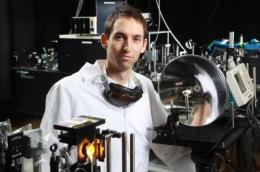
Morrow will graduate from Rensselaer with a doctorate in ,, applied physics, and astronomy.
Student Innovation Could Improve Data Storage, Magnetic Sensors.
Morrow's,of the magnetic and non-magnetic layers creates a material that exhibits promising magnetic properties for data storage
Paul Morrow has come a long way from his days as an elementary school student, pulling apart his mother's cassette player. The talented young physicist has developed two innovations that could vastly improve magnetic data storage and sense extremely low level magnetic fields in everything from ink on counterfeit currency to tissue in the human brain and heart.
First, Morrow developed a nanomaterial that has never before been produced. The nanomaterial is an array of freestanding nanoscale columns composed of alternating layers of magnetic cobalt and non-magnetic copper.
Morrow's three-dimensional arrangement of the magnetic and non-magnetic layers creates a material that exhibits promising magnetic properties for data storage and magnetic field sensing at room temperature. Similar technology is currently in use in hard drives around the world, but they both use a two-dimensional film design for the layers.
"Because the nanostructure is three-dimensional, it has the potential to vastly expand data storage capability," Morrow said. "A disk with increased data storage density would reduce the size, cost, and power consumption of any electronic device that uses a magnetic hard drive, and a read head sensor based on a small number of these nanocolumns has promise for increasing spatial sensitivity, so that bits that are more closely spaced on the disk can be read. This same concept can be applied to other areas where magnetic sensors are used, such as industrial or medical applications."
Morrow has also developed a microscopic technique to measure the minute magnetic properties of his nanocolumns. Prior to his innovation, no such method existed that was fine-tuned enough to sense the magnetic properties of one or even a small number of freestanding nanostructures.
The technique uses a specialized scanning tunneling microscope (STM) that Morrow built that contains no internal magnetic parts. Most STMs in use today have magnetic parts that make it impossible for them to operate reliably in an external magnetic field according to Morrow. With his modified non-magnetic STM, Morrow was able to use an electromagnet to control the magnetic behavior of his nanocolumns and measure the magnetic properties of fewer than 10 nanocolumns at one time
To date it has been extremely difficult to get an instrument to detect magnetic properties on such a small scale," Morrow said. "With this type of sensitivity, engineers will be able to sense the very low level magnetic properties of a material with sub-micron spatial resolution."
He is currently working to fine-tune the device to detect the properties of just one nanocolumn. His technique could have important implications for the study of other magnetic nanostructures for magnetic sensing applications including motion sensors for industrial applications, detection of magnetic ink in currency and other secure documents, and even help detect and further understand the minuscule magnetic fields generated by the human body.
His discoveries have been published in two articles in the journal Nanotechnology.
Morrow proudly originates from the city of Spartanburg, S.C., the only boy in a close family that includes three sisters. His father is a retired chemistry professor at Wofford College, the local liberal arts college that Morrow attended for his bachelor's, and his mother is a master teacher who instructs elementary schoolteachers in improving their teaching methods. "Their love of learning and teaching has inspired me to one day become a teacher myself," Morrow said.
more..............
PaulMorrowResearch
Paul
MorrowPh.D. Project
Title: "Contact magneto-resistance measurements of multilayered nanostructures measured by non-magnetic scanning tunneling microscope"
As of May 2006, I am officially a Ph.D. candidate, passing my Candidacy Examination on 4-26-2006. In my main research project, I designed and built a non-magnetic STM to serve as a contact nanoprobe to measure the current-perpendicular-to-plane giant magneto-resistance (CPP-GMR) of multilayered Co/Cu nanocolumns grown by oblique angle thermal evaporation. The STM module I built was designed to be integrated into a pre-existing ultrahigh vacuum (UHV)-STM system, and it is constructed of nonmagnetic materials so it can operate fairly well in an external magnetic field. I have added a small electromagnet to magnetize the sample during measurement; initially, the electromagnet could reach fields of 1.8 kOe, but after rewrapping the magnet wire a little more tightly, and attaching pole extensions to concentrate the field at the center of the gap, it can now get up to nearly 3 kOe.
Here are some pictures of my STM.
Current-in-plane giant magneto-resistance (CIP-GMR) was first reported in 1988; it is characterized by a large drop in the resistance when an external magnetic field is applied to multilayered ferromagnetic/nonmagnetic (F/N) films with the current flowing in the plane of the layers that make up the film. In 1997 it revolutionized the magnetic recording industry by reducing the size of the read head on computer hard drives, and just this year (2007) the scientists who discovered GMR (Albert Fert and Peter Grünberg) received the Nobel Prize in Physics. Later, the CPP geometry became an area of interest, for two reasons. First, the respective scaling lengths for CIP-and CPP-GMR are the mean free path (λ ~ 1-10 nm) and spin diffusion length (l ~ 10-100 nm) of an electron; this implies that devices based on CPP-GMR can be controlled more precisely due to the less stringent tolerances on dimension. Also, CPP-GMR values are generally higher than CIP-GMR, which makes it the more attractive of the two for sensing and switching applications. Wire- or column-shaped nanostructures with multilayered F/N design are preferable for work in CPP-GMR because their reduced lateral dimension increases their resistance, allowing GMR to be observed more easily (especially at room temperature).

No comments:
Post a Comment